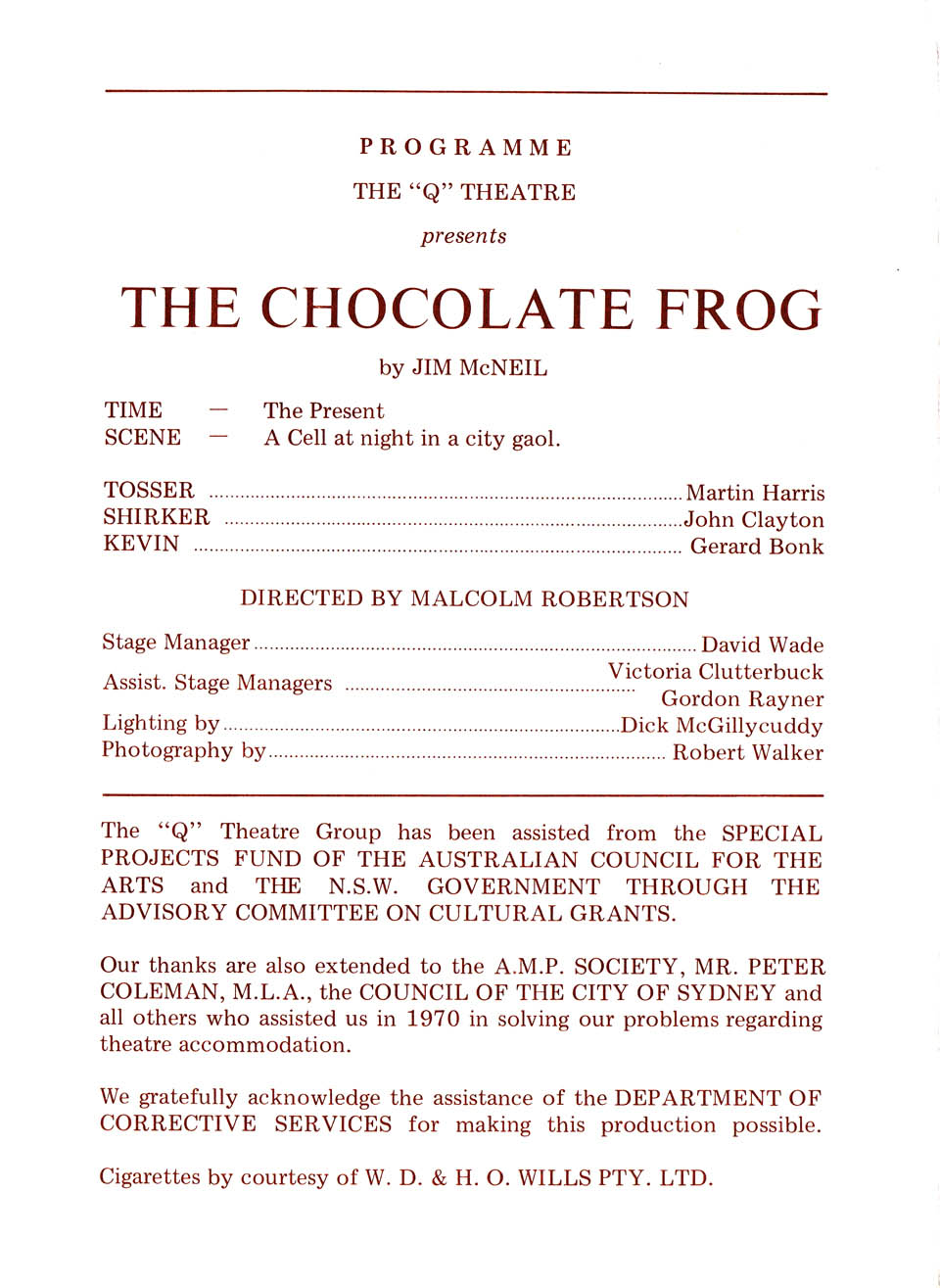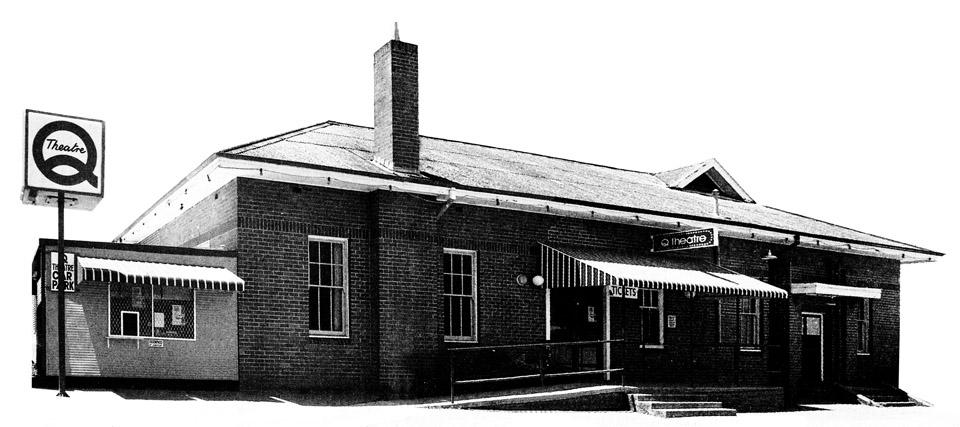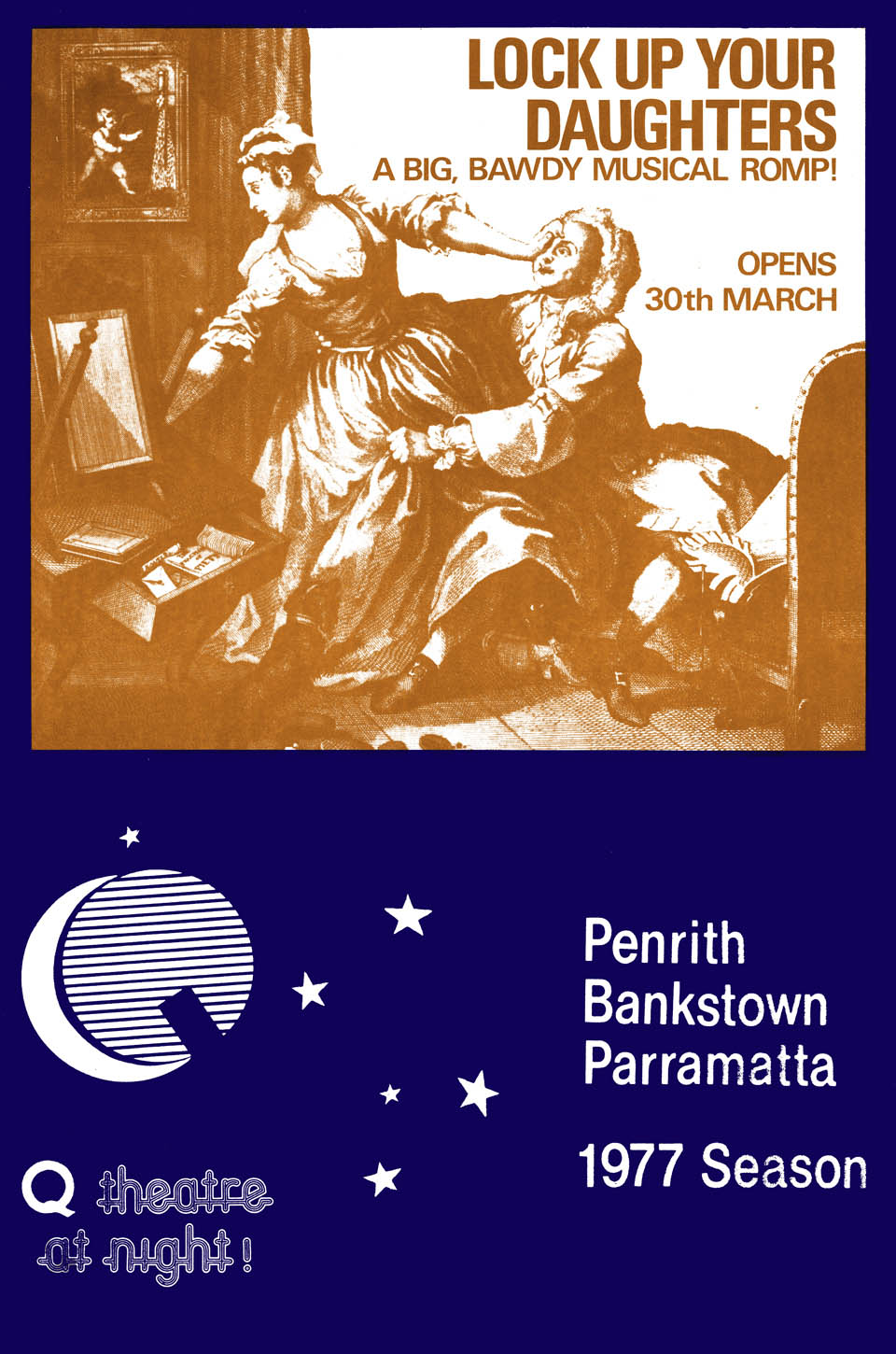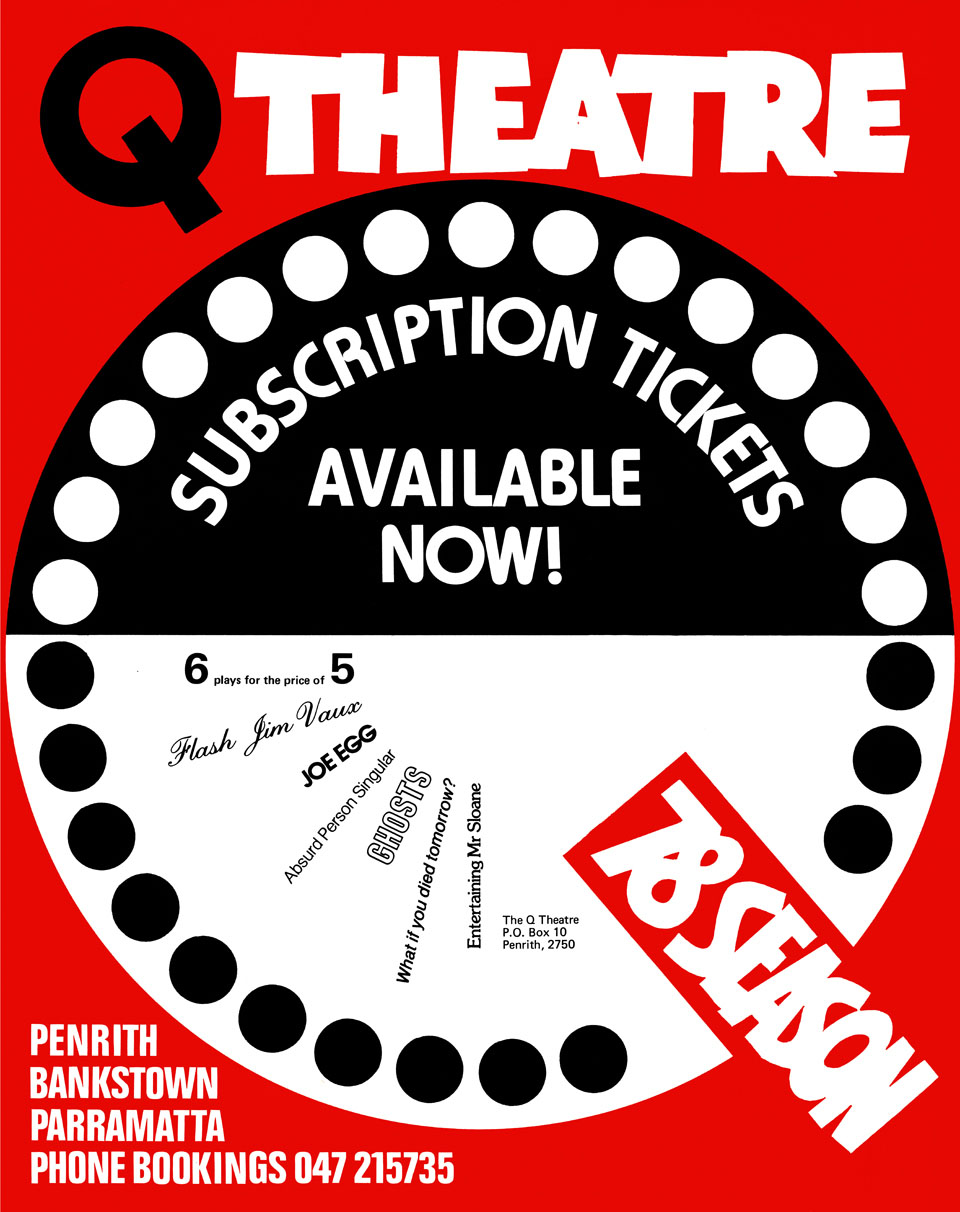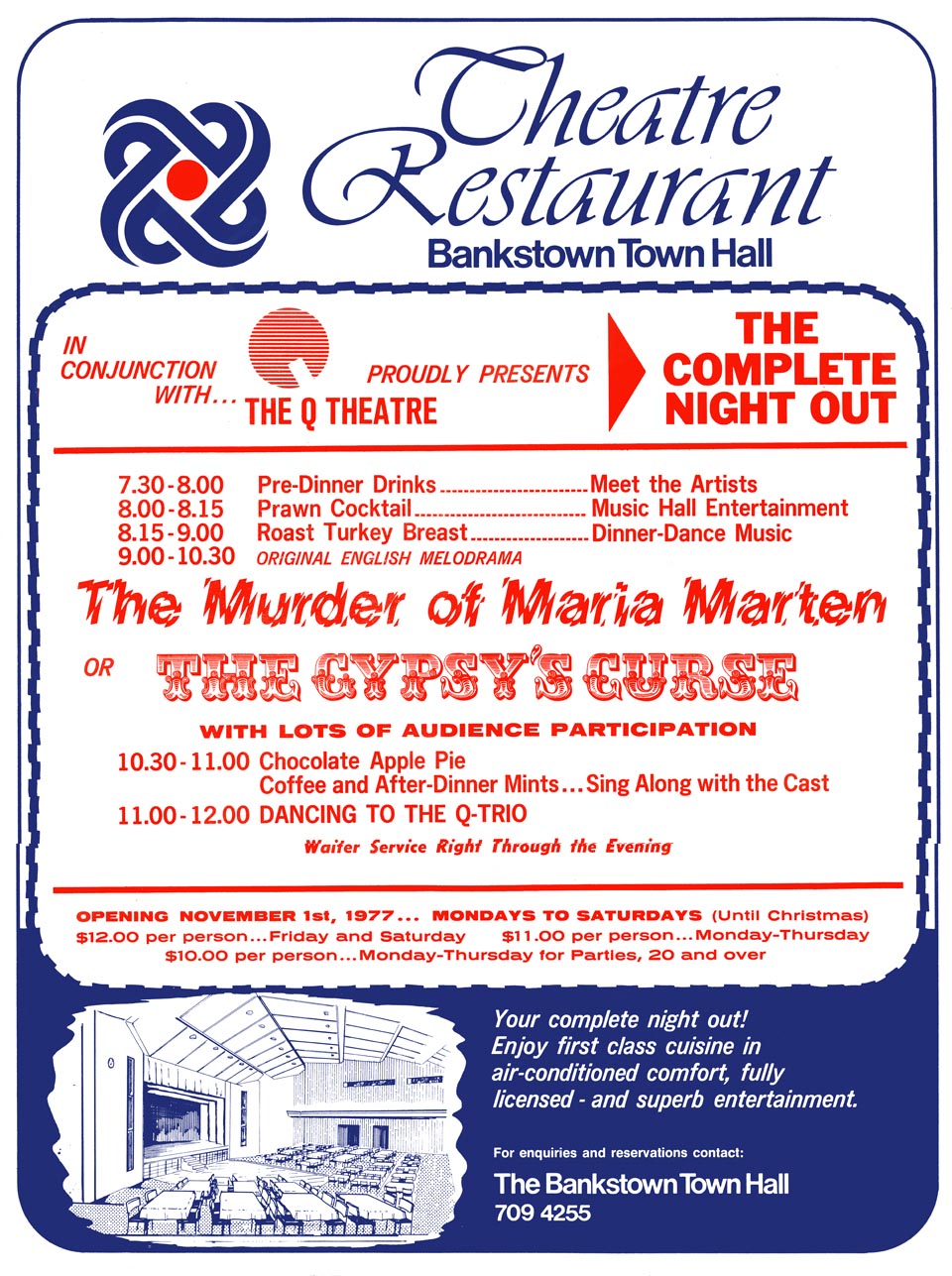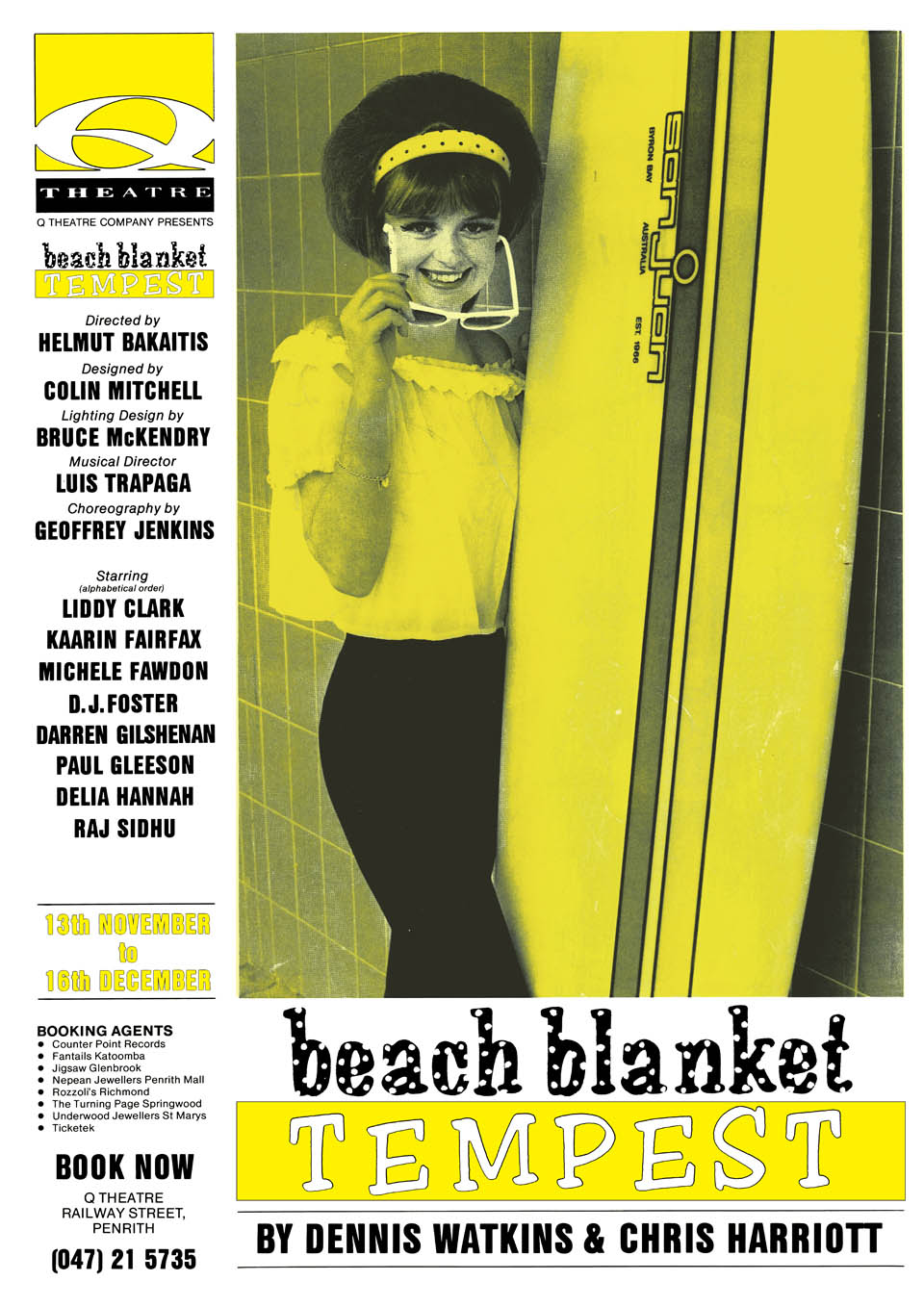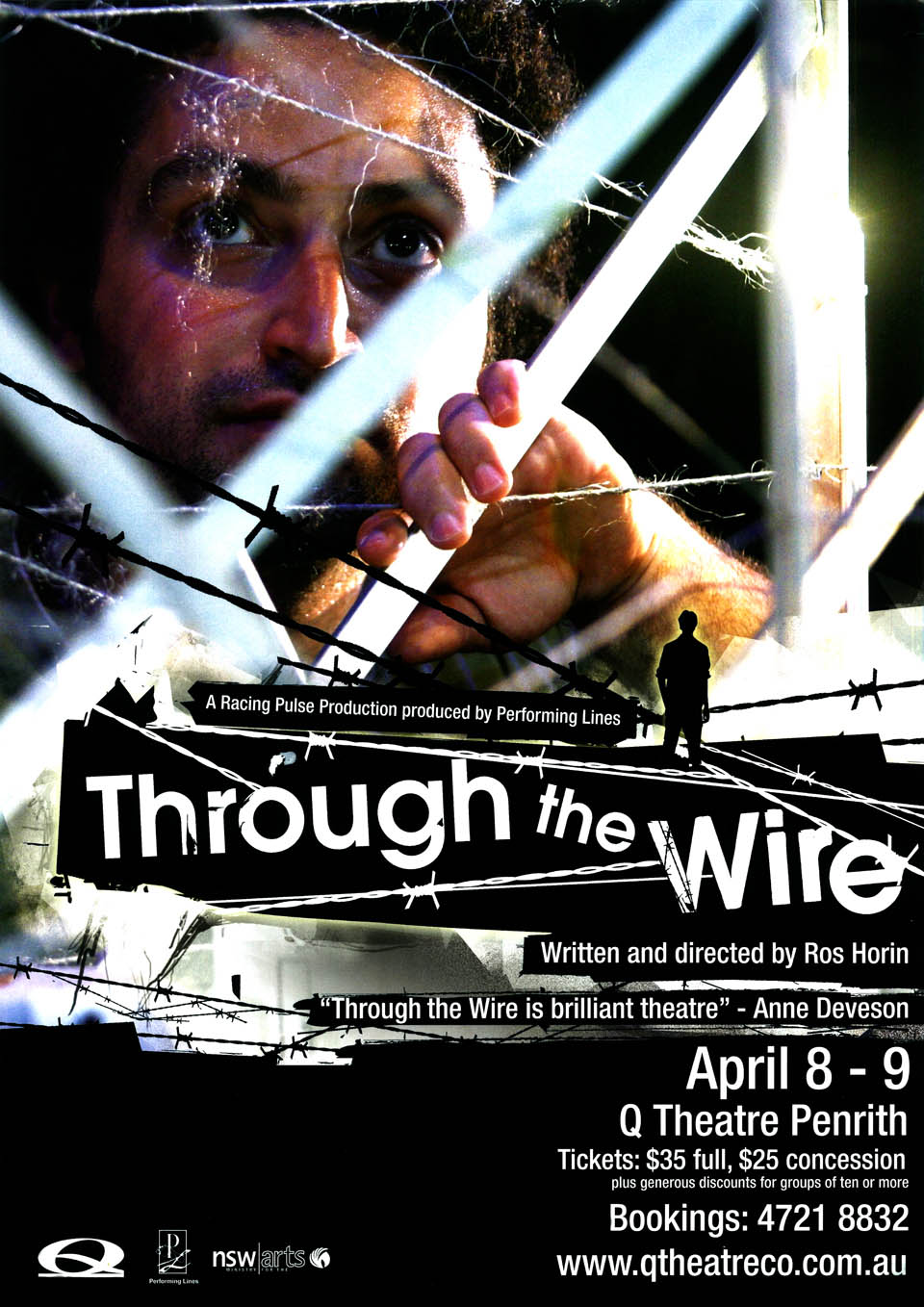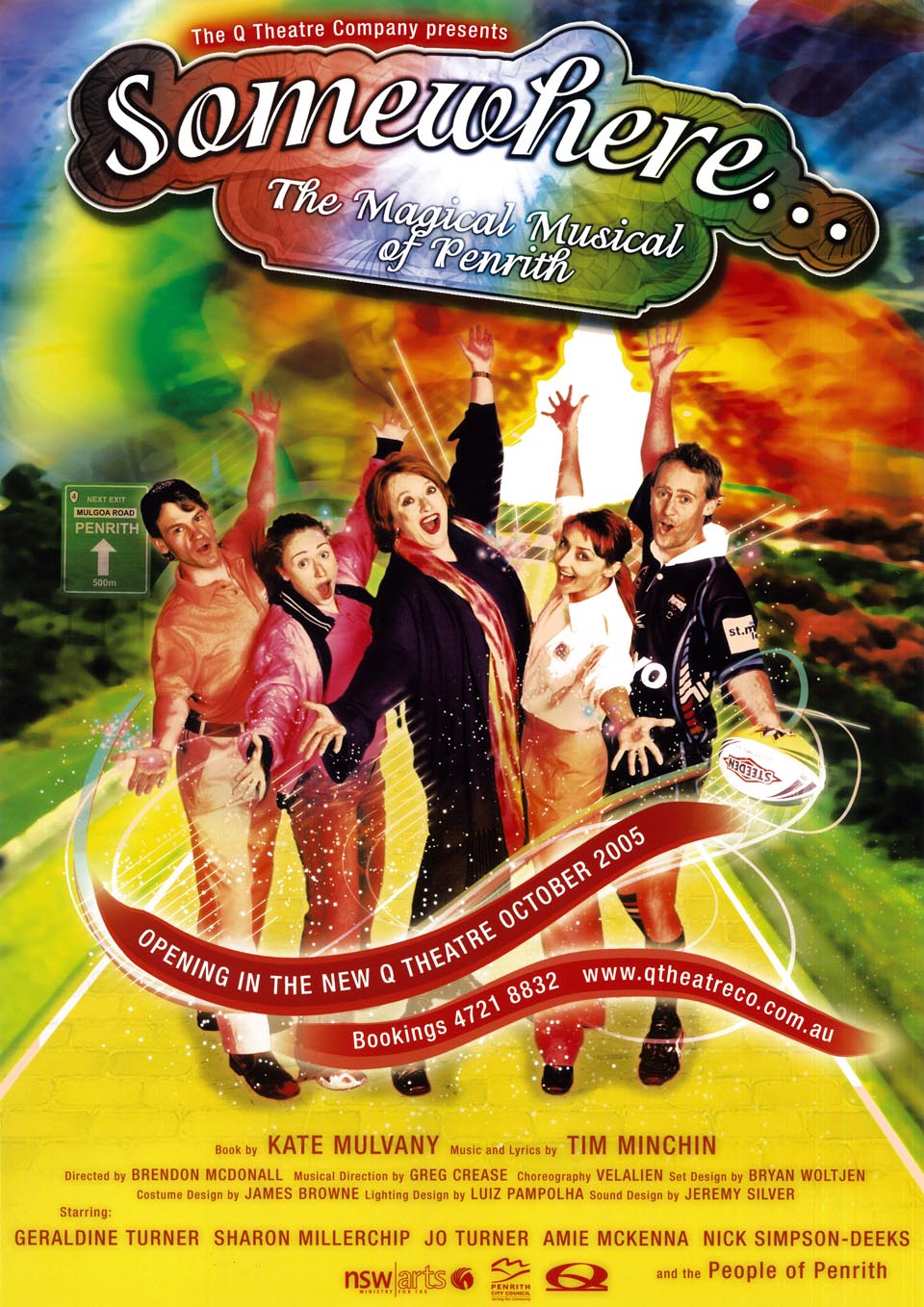The Dictionary of Sydney was archived in 2021.
Q Theatre
Citation
Persistent URL for this entry
To cite this entry in text
To cite this entry in a Wikipedia footnote citation
To cite this entry as a Wikipedia External link
Q Theatre
[media]The Q Theatre was both a product of its time and the creation of one dedicated artist. It began in 1963 when actor Doreen Warburton gathered a group of five professional performers – Ben Gabriel (later Warburton's life partner), Edward Hepple, Robert McDarra, Terry McDermott and Walter Sullivan – to form a theatre company. Each actor contributed five pounds to establish the project. [1] [media]There were mixed motives for this action. English born Warburton had worked with and been inspired by the highly successful British Theatre Workshop and hoped to emulate it. That group, led by Joan Littlewood, had come together in Kendal in northern England because they were dissatisfied with commercial theatre 'on artistic, social and political grounds' and instead sought more unconventional production styles and experimental plays. [2] Interesting plays and television scripts were being written at the time in Britain and Europe but these works were not being performed in Australia and, in practical terms, there was little work available for stage actors in Sydney. [3]
Lunchtimes in the AMP Building
[media]With considerable help from friends and family in providing equipment and front-of-house services, Warburton's group began lunchtime performances in the comfortable 250-seat theatrette of the AMP Building at Circular Quay, initially under the name AMP-I-theatre. [4] The group changed its name to the Q Theatre for its second show. [5] It opened on 2 December 1963 with a production of Harold Pinter's 'The Dumb Waiter', playing two shows a day, one at 12 noon, another at 1 pm, at three shillings admission. [6]
Pinter was a controversial choice for an opening work at this time, but having received moderate audience support, and a welcome £150 contribution from the Playgoers' Club, the Q began a season of eight more plays, each running for three weeks. [7] Plays were usually of around 40-50 minutes duration, with a programme of works by modern and contemporary writers. These shows included Mortimer's 'The Dock Brief', which was such a hit that people had to be turned away, Chekhov's 'The Proposal', and an [media]ambitious pantomime, 'Dick Wittington and his Cat.' Opportunities also arose for lesser known local playwrights, such as Colin Free, while the Q's first full-length evening production in 1966 was Ray Lawler's 'The Summer of the Seventeenth Doll.' [8]
A touring company
[media]By 1966 the Q Theatre had given 17 original productions at the AMP theatrette and expanded its working membership to 16 people, including two long-serving directors, Ron Ferrier and Peter Collingwood. [9] The Q also gave opportunities to younger directors, among them Jim Sharman, Rick Billinghurst and Rex Cramphorn. The company gave benefit performances at other venues, including the Independent Theatre and the University of New South Wales. [10] In May 1965 four of the actors, with NSW Arts Council support, toured four plays for over six months, travelling 18,000 miles (28,970 kilometres) over much of Australia. [11] By the early 1970s the Q's repertoire had expanded to 67 plays, including eight new Australian works. [12]
The company initially depended on voluntary labour and none of the original members received wages but the Q always paid Actors' Equity rates for outside professionals and met working expenses. It also received assistance in kind, such as wardrobe and properties, from the Australian Elizabethan Theatre Trust. [13] Nonetheless finances were a continuing problem for the Q, particularly since its policy was always to keep admission costs low – 85 cents a ticket, 60 cents for pensioners and students – to ensure that theatre was accessible to all. [14]
Taking theatre to the people
[media]In 1968, however, the Q obtained sufficient subsidy from the Federal Arts Council and the New South Wales Government to allow it to develop on its philosophy of bringing theatre to the people. From 1970, encouraged by union support, particularly from the Builders Labourers Federation, it performed in workplaces. In November 1971, at the unfinished Sydney Opera House, the Q staged a well-received production of Jim McNeil's 'The Chocolate Frog', which it had premiered in July. Other venues included Waverley Bus Depot, Chullora Railway Workshops, and factories and building sites located in twelve of the western suburbs of Sydney. From 1974, with the support of Bankstown City Council, the Q also ran regular lunch hour seasons at the Bankstown Civic Centre. [15]
During this period the company implemented its long-held commitment to educating audiences and training performers. It established theatre workshops around its touring circuit. From 1976 these free weekend one-day courses ran for ten-week periods in 13 venues, ranging geographically from Sutherland to Castle Hill and later Mount Druitt. [16]
The move to Penrith
[media]From 1975 the Q felt the need for expanded facilities, so as to produce works of greater length. [17] A rent increase at the AMP Theatrette, as well as a desire to emulate the operation of its model Theatre Workshop, influenced the Q's search for a provincial and permanent location. [18] There were several options, including Campbelltown, Parramatta and Bankstown (which had modern theatre facilities), but the choice was made to move to Penrith. Among the factors influencing the decision was support from Penrith City Council, which offered the company the then-vacant Railway Institute Building, although without any financial aid. The Q considered there was a strong community feel in the area and received active support from local cultural organisations including Little Theatre and music groups. [19]
Warburton's dream of taking her professional company to live and work in Penrith did not eventuate but she and Gabriel did move to the area and were followed by actors Vola Vandere, Ron Hackett, Ron Rodger, Linden Wilkinson and Leo Taylor. [20] All the members of the new company received the same wage of $150 a week. Two other Q members who moved to Penrith were Arthur Dicks, a designer and director, and Richard Brooks, a director and teacher. Both were English-trained theatricals, and would later become Warburton's co-artistic directors. [21]
In 1976 the Q closed the lunchtime theatre in Sydney and set about creating a fully professional theatre organisation in Penrith. The plan was to present two-week subscription seasons of night-time productions followed by week long tours to Bankstown and Parramatta.
[media]There was, as Warburton had anticipated, considerable active local involvement from interested supporters of the proposed new theatre. Encouraged by Warburton's skill in relating to people and enlisting their help, residents raised very necessary funds helped with goods, on-site preparations and the provision of props and wardrobe. [22] The Railway Institute Building was converted to a 126-seat thrust stage theatre at a cost of $7500.
Glory days at the Railway Institute Building
[media]The Q opened in Penrith on 30 March 1977 with the contemporary hit musical 'Lock Up Your Daughters.' The season that followed reflected the Q's longstanding policy of presenting challenging and interesting plays. It comprised 'Flash Jim Vaux', 'A Day in the Death of Joe Egg', 'Absurd Person Singular', 'Ghosts', 'What If You Died Tomorrow' and 'Entertaining Mr Sloan.' [23]
[media]It was the intention of the Q's artistic administrators that the new permanent company be supplemented with visiting guest artists. It was also hoped that local performers, who had come through the Q's own teaching structure, would be engaged with the company. From 1978 the theatre training programme, led by Richard Brooks, was expanded from ad hoc early gatherings to formal class structures. By 1981 there was a graded range of courses with, at its apogee, a two-year intensive professional training programme. By 1984 the Q's teaching arm had around 150 enrolled students. [24] [media]Within this successful system, there were professional opportunities for other young artists and the Q provided the venue for early appearances by performers such as Judy Davis and, in 1990, Toni Colette. [25]
[media]The mid-1970s to the mid-1980s was a successful period for the Q theatre. By encouraging community engagement, making the theatre available for other organisations and activities, a low price policy and an energetic and engaging house-style of production, the Q achieved close to 94 percent capacity at its shows by 1980. [26] The repertoire continued to favour the hard-hitting style of writers such as Alan Ayckbourn, Sam Shepard and Joe Orton, but the company also explored locally evocative themes, with rock musicals such the successful 'St Mary's Kid' of 1978 and the enduring nationalist appeal of 'On Our Selection' and 'The Sentimental Bloke.' [27] Over seven years, four nights a week from March to December, the Q staged 33 productions and undertook extensive tours of shows, although venue problems ended the tours to Bankstown and Parramatta in 1980. [28] [media]The Q Theatre's status was reinforced by a Sydney Critics' Circle Award for its production of Shaw's 'The Devil's Disciple', which had transferred briefly to the Sydney Opera House in 1979. The same year Warburton received an OBE for her theatre work. [29]
The Q2
[media]One result of this box office and community success was that, in 1981, a decision was made to create a new theatre. The Q Theatre company designed it themselves, using the same site, with the shape and atmosphere of the existing Q but with improved facilities. [30] There was to be seating for 270 people at an estimated cost of $350,000. A local quest for funds raised $35,000, in part by the sale of sponsored seats in the new theatre at a cost of $54 each. With assistance from the Australia Council, the New South Wales Government and a grant from the Penrith City Council, the theatre, named Q2, with modern seating, air conditioning and a bar, reopened on 17 November 1982 with the perennial crowd pleaser 'Charley's Aunt.' The official opening ceremony on 9 April 1983 coincided with the company's twentieth anniversary and consisted of a musical production of CJ Dennis' 'The Sentimental Bloke.' [31]
All seemed set fair for the Q and its shows and activities continued to attract audiences and local support into the mid-1980s. Times were, however, changing. The successful actor/manager/artistic director of the 'Little Theatre' tradition was being supplanted. Warburton, who was the inspiration and public face of the Q and was known to her company as 'Mum', was growing older. So were her co-artistic directors. Warburton retired from the Q in 1989. [32] Egil Kipske briefly filled her role of artistic director before Helmut Bakaitis was appointed to the position. [33]
This was not merely an artistic baton-change. It took place against social and cultural changes in Australia and a transformation of the Penrith district. By the beginning of the 1990s the personal approach and social values of community engagement that underlay the Q Theatre's operation were challenged by concepts of economic rationalism and business professionalism.
By 1984 there were hints of financial pressures and a falling off in local support. [34] In 1983 the Q reinforced its support base by establishing the Q Theatre Development Council. This was a group of invited self-styled patrons whose role was to support the Q both by using their own networks and by fund raising. Led by local arts patron Jean McSweeny, the council included among its members the high-profile figures Sir Robert Helpmann and Freda Whitlam. [35] Following Warburton's retirement, however, the Board of the Q, perhaps influenced by the zeitgeist, became concerned more with financial and bureaucratic concerns than the artistic ones that were the theatre's strength. [36]
The demography of Penrith was also changing, from a close rural community to an upwardly mobile population of young families, oriented towards work in the Sydney area, and less engaged with local support networks. [37] The Q Theatre started to lose its base. The problems included a shrinking subscriber list, a degree of both natural attrition and lessening enthusiasm from volunteers, and a simple lack of engagement among local people, apart from a small number of university-focused residents who often lived in the Blue Mountains. [38]
The Railway Street Theatre Company
[media]The new artistic director Bakaitis, an actor, director and dramatist with extensive experience in theatre for young people, tried to accommodate changing morés. He held the position of artistic director for over seven years and programmed a wide range of plays, from classics to Australian to musicals. There were successes in each season's deliberately mixed bag, including his own Shakespearean adaptation 'Beach Blanket Tempest.' [39] Bakaitis was, however, unable to establish the right balance between the available plays and the expectations of his community. Some plays, particularly those by modern Australian playwrights, were perceived as too rough and outspoken, and some were too confronting to an upwardly mobile community perhaps still unsure of its own cultural values. [40]
Bakaitis also faced the financial reality of lessening engagement from Penrith City Council and continuing cuts to Federal funding through the Australia Council. By the late 1990s the Q's only remaining regular source of funding was the NSW Ministry for the Arts. In 1998 the Australia Council shifted its funding model from supporting infrastructure to backing individual artists, so the Q sought to ensure its survival by amalgamating with the similarly stricken New England Theatre Company. [41] The merger resulted in the creation, in Penrith, of the Railway Street Theatre Company, although the building retained the title of the Q Theatre. Mary Anne Gifford became artistic director of both companies with Dallas Lewis as the joint general manager. It was not a rewarding arrangement, although it lasted until 2003, for it exacerbated the financial and operational pressures on both companies. [42] The emphasis on touring meant the Q venue became increasingly run down. [43]
[media]Concurrently, the New South Wales Ministry for the Arts streamlined funding for the arts by centralising organisations and venues. From 2002 these plans included a proposal to extend the existing Joan Sutherland Performing Arts Centre in Penrith. [44] This met with a positive response from Penrith City Council and the then Railway Street Theatre Company began lobbying to have a new Q as part of extended development of the Centre. [45] The Board of the Railway Street Theatre Company created a new position of general manager/producer and appointed David Hollywood to oversee the move to the new theatre, which was to be named Q3. The Q Theatre gave its last plays at Q2 in 2005. As was the Q's tradition, these were challenging and interesting works, including 'The Shoe Horn Sonata' and Ros Horin's compelling account of the detainee experience, 'Through the Wire.' [46]
The Q moves to the Joan
[media]The redeveloped Joan Sutherland Performing Arts Centre (known more simply as 'the Joan') reopened in 2005. The building included a 378-seat purpose-built theatre, now referred to as the Q or Q theatre, rather than Q3. The Q Theatre as an organisation moved to the new venue and reopened in October 2005 with their production of 'Somewhere – the Magical Musical of Penrith.' [47] The former Railway Institute, the home of the Q for 27 years, was demolished in mid 2006. [48]
[media]Two years later, in 2007, the Q merged with the Joan Sutherland Performing Arts Centre and Penrith Regional Gallery & The Lewers Bequest to become part of the not-for-profit organisation Penrith Performing and Visual Arts. Late in 2007 the company was relaunched as The Q Theatre Company. [49]
References
Phyllis Hartnoll, ed. The Oxford Companion to the Theatre. Oxford: Oxford University Press, 1983. Fourth edition
Q Theatre 84: 1963-1984. Penrith: Q Theatre Group, 1984
A Marshall, ed. The Q Story 1977-2005. Penrith: Railway Street Theatre Company, 2005
Notes
[1] Ailsa Carpenter, 'The Q's Two Decades + 1,' in Q Theatre 84: 1963-1984 (Penrith: Q Theatre Group, 1984)
[2] Phyllis Hartnoll, ed, The Oxford Companion to the Theatre, 4th ed (Oxford: Oxford University Press, 1983), 826
[3] Ailsa Carpenter, 'The Q's Two Decades + 1,' in Q Theatre 84: 1963-1984 (Penrith: Q Theatre Group, 1984)
[4] 'Q Theatre Company,' in Companion to Theatre in Australia, ed P Parsons and V Chance (Paddington: Currency Press in association with Cambridge University Press, 1995), 471; Ailsa Carpenter, 'The Q's Two Decades + 1,' in Q Theatre 84: 1963-1984 (Penrith: Q Theatre Group, 1984); Joan Sutherland Performing Arts Centre Archives, Q Theatre 'Lunch Hour Plays' poster, 29 January 1964
[5] Q Theatre Company, AusStage, http://www.ausstage.edu.au/pages/organisation/121, viewed 8 November 2014
[6] Ailsa Carpenter, 'The Q's Two Decades + 1,' in Q Theatre 84: 1963-1984 (Penrith: Q Theatre Group, 1984)
[7] Ailsa Carpenter, 'The Q's Two Decades + 1,' in Q Theatre 84: 1963-1984 (Penrith: Q Theatre Group, 1984)
[8] Ailsa Carpenter, 'The Q's Two Decades + 1,' in Q Theatre 84: 1963-1984 (Penrith: Q Theatre Group, 1984)
[9] Ailsa Carpenter, 'The Q's Two Decades + 1,' in Q Theatre 84: 1963-1984 (Penrith: Q Theatre Group, 1984); 'Lunch Hour Productions Q Theatre Company,' in Q Theatre 84: 1963-1984 (Penrith: Q Theatre Group, 1984)
[10] Ailsa Carpenter, 'The Q's Two Decades + 1,' in Q Theatre 84: 1963-1984 (Penrith: Q Theatre Group, 1984)
[11] Walter Sullivan, 'Touring with the Q,' in Q Theatre 84: 1963-1984 (Penrith: Q Theatre Group, 1984)
[12] Ailsa Carpenter, 'The Q's Two Decades + 1,' in Q Theatre 84: 1963-1984 (Penrith: Q Theatre Group, 1984)
[13] Ailsa Carpenter, 'The Q's Two Decades + 1,' in Q Theatre 84: 1963-1984 (Penrith: Q Theatre Group, 1984)
[14] Ailsa Carpenter, 'The Q's Two Decades + 1,' in Q Theatre 84: 1963-1984 (Penrith: Q Theatre Group, 1984); Doreen Warburton, 'An Epic Tale,' in The Q Story 1977-2005, ed A Marshall (Penrith: Railway Street Theatre Company, 2005)
[15] Ailsa Carpenter, 'The Q's Two Decades + 1,' in Q Theatre 84: 1963-1984 (Penrith: Q Theatre Group, 1984)
[16] Ailsa Carpenter, 'The Q's Two Decades + 1,' in Q Theatre 84: 1963-1984 (Penrith: Q Theatre Group, 1984) Richard Brooks, 'The Q Theatre Workshops,' in Q Theatre 84: 1963-1984 (Penrith: Q Theatre Group, 1984)
[17] 'Q Theatre Company,' in Companion to Theatre in Australia, ed P Parsons and V Chance (Paddington: Currency Press in association with Cambridge University Press, 1995), 471
[18] 'Q Theatre Company,' in Companion to Theatre in Australia, ed P Parsons and V Chance (Paddington: Currency Press in association with Cambridge University Press, 1995), 471
[19] Doreen Warburton, 'An Epic Tale,' in The Q Story 1977-2005, ed A Marshall (Penrith: Railway Street Theatre Company, 2005); Personal communication with Valda Silvy and Dr Malcolm Borland, Joan Sutherland Performing Arts Centre, Penrith, 25 November 2014
[20] Bill Conn, 'Extended Family,' and Doreen Warburton, 'An Epic Tale,' in The Q Story 1977-2005, ed A Marshall (Penrith: Railway Street Theatre Company, 2005)
[21] A Marshall 'Three Ring Circus,' in The Q Story 1977-2005, ed A Marshall (Penrith: Railway Street Theatre Company, 2005)
[22] Personal communication with Valda Silvy and Dr Malcolm Borland, Joan Sutherland Performing Arts Centre, Penrith, 25 November 2014
[23] 'Q Theatre – Penrith production list,' Q Theatre 84: 1963-1984 (Penrith: Q Theatre Group, 1984)
[24] Richard Brooks, 'The Q Theatre Workshops,' Q Theatre 84: 1963-1984 (Penrith: Q Theatre Group, 1984)
[25] Richard Brooks, 'The Q Theatre Workshops,' Q Theatre 84: 1963-1984 (Penrith: Q Theatre Group, 1984); A Marshall ed, The Q Story 1977-2005 (Penrith: Railway Street Theatre Company, 2005)
[26] Bill Conn, 'Three Ring Circus,' in The Q Story 1977-2005, ed A Marshall (Penrith: Railway Street Theatre Company, 2005)
[27] David Hoey, 'What an Education,' in The Q Story 1977-2005, ed A Marshall (Penrith: Railway Street Theatre Company, 2005)
[28] Ailsa Carpenter, 'The Q's Two Decades + 1,' in Q Theatre 84: 1963-1984 (Penrith: Q Theatre Group, 1984)
[29] Ailsa Carpenter, 'The Q's Two Decades + 1,' in Q Theatre 84: 1963-1984 (Penrith: Q Theatre Group, 1984)
[30] Doreen Warburton, 'An Epic Tale,' in The Q Story 1977-2005, ed A Marshall (Penrith: Railway Street Theatre Company, 2005)
[31] Ailsa Carpenter, 'The Q's Two Decades + 1,' in Q Theatre 84: 1963-1984 (Penrith: Q Theatre Group, 1984)
[32] Bill Conn, 'Extended Family,' in The Q Story 1977-2005, ed A Marshall (Penrith: Railway Street Theatre Company, 2005)
[33] 'Q Theatre Company,' in Companion to Theatre in Australia, ed P Parsons and V Chance (Paddington: Currency Press in association with Cambridge University Press, 1995), 471
[34] Chairman Gerard Bulters, in Q Theatre 84: 1963-1984 (Penrith: Q Theatre Group, 1984)
[35] Jean McSweeny, 'The Q Theatre Development Council', in Q Theatre 84: 1963-1984 (Penrith: Q Theatre Group, 1984)
[36] 'Balancing Chairs' and Patricia Parker, 'Not Just,' in The Q Story 1977-2005, ed A Marshall (Penrith: Railway Street Theatre Company, 2005)
[37] 'High Wire Act. Finding the Balance,' in The Q Story 1977-2005, ed A Marshall (Penrith: Railway Street Theatre Company, 2005)
[38] Helmut Bakaitis, 'Seven Years at the Q,' in The Q Story 1977-2005, ed A Marshall (Penrith: Railway Street Theatre Company, 2005)
[39] Helmut Bakaitis, 'Seven Years at the Q,' in The Q Story 1977-2005, ed A Marshall (Penrith: Railway Street Theatre Company, 2005)
[40] Helmut Bakaitis, 'Seven Years at the Q,' in The Q Story 1977-2005, ed A Marshall (Penrith: Railway Street Theatre Company, 2005); Ellen McIntosh, Penrith Press, cited 'High Wire Act. Finding the Balance,' in The Q Story 1977-2005, ed A Marshall (Penrith: Railway Street Theatre Company, 2005)
[41] History of the Q Theatre Company, The Joan, http://thejoan.com.au/about-us/q-theatre-company/history-q-theatre-company/, viewed 21 January 2015
[42] 'The Railway Years' in The Q Story 1977-2005, ed A Marshall (Penrith: Railway Street Theatre Company, 2005); Mary Anne Gifford, 'A New Act – and they loved it,' in The Q Story 1977-2005, ed A Marshall (Penrith: Railway Street Theatre Company, 2005)
[43] Sarah Woods, 'A Theatre with Heart', in The Q Story 1977-2005, ed A Marshall (Penrith: Railway Street Theatre Company, 2005)
[44] Personal communication with John Mullane (former Chairman of Board of Railway Theatre Company), Penrith, 19 January 2015
[45] Grant McBride, Q Theatre, Penrith, Private Members Statements, Legislative Assembly, Hansard, 11 December 2005, http://www.parliament.nsw.gov.au/prod/parlment/hansart.nsf/V3Key/LA20051011042, viewed 8 November 2014
[46] 'The Q's Professional Seasons from 1977-2005,' in The Q Story 1977-2005, ed A Marshall (Penrith: Railway Street Theatre Company, 2005)
[47] At least two of the contributors to that production went on to enjoy wider reputations. The show was written by playwright Kate Mulvany and Tim Minchin created the music and lyrics. Karyn Paluzzano, Q Theatre, Penrith, Private Members Statements, Legislative Assembly, Hansard, 11 December 2005, http://www.parliament.nsw.gov.au/prod/parlment/hansart.nsf/V3Key/LA20051011042, viewed 8 November 2014
[48] Telephone communication with Local Studies Librarian, Local Studies Collection, Penrith City Library, 19 January 2015, citing Western Weekender, 21 July 2006
[49] History of the Q Theatre Company, The Joan, http://thejoan.com.au/about-us/q-theatre-company/history-q-theatre-company/, viewed 21 January 2015








